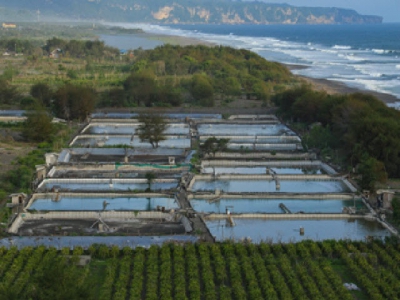Indonesia unlikely to realize ambitious shrimp-sector growth target

In March 2020, Indonesia’s government set the ambitious target of increasing the country’s shrimp export earnings by 250 percent by 2024.
Indonesian Fisheries Minister Edhy Prabowo said in February the target was in line with the country increasing its shrimp production from 410,000 MT of production in 2019 to 578,000 metric tons in 2024.
However, shrimp sector experts are casting doubt on the government’s plan, calling it unrealistic.
“With regards to a 250 percent increase of vannamei in the next five years, I think it is impossible,” Patrik Henriksson, a researcher at Stockholm University and the Malaysia-based nonprofit research organization Worldfish, who has conducted several studies on Indonesian seafood sector, told SeafoodSource. “Partially because infrastructure is not there to support such an increase (including feed mills), partially because the global market for feed resources is getting ever more competitive.”
Henriksson said local fish stocks historically used for fishmeal production in Indonesia have been overexploited. Therefore, the country will have to rely on imports to meet demand – not an easy task, as global supply is also limited.
“Moreover, such short-term expansions could easily result in ecological disaster, with regards to mangrove forests, coral reefs, and wild fish stocks,” he said, adding that deteriorating water quality due to deforestation is an issue for aquaculture farmers in Sumatra. Moreover, disease is always a threat to any aquaculture operation, especially shrimp farming, Henriksson said.
Shrimp Insights Founder Willem van der Pijl noted in an August report that shrimp exports from Indonesia to the United States in the first half of 2020 rose 27 percent year-on-year and were up 41 percent from H1 2017. He attributed the growth to the expansion of intensive shrimp farms across Indonesia, particularly in areas such as Sukabumi District in West Java, which were identified by the government as focus zones for encouraging the development of sustainable shrimp sector growth.
In recent years, shrimp farming has grown rapidly beyond the traditional hubs in Lampung and East Java, with new farming clusters being developed in Sulawesi and the eastern parts of Indonesia, especially East Nusa Tenggara. These new geographies – now loaded with high-density farms – are expected to play a more important role in Indonesia’s shrimp production in the future. Currently, semi-intensive farms in traditional regions produce a majority of the country’s vannamei output.
However, van der Pijl still thought the 2024 targets set by the Indonesian government seem overly ambitious.
“While 2020 showed some positive signs, data of previous years don’t yet make me foresee a 250 percent shrimp export growth,” he said.
Indonesia has exported between 140,000 MT and 200,000 MT of shrimp since 2010, with vannamei accounting for 85 percent of total export volumes in 2019. The country’s xport volumes rose to 194,000 MT last year, up from 170,000 MT in 2017 and 185,000 MT in 2015. Total export growth between 2010 and 2019 was 38 percent, or 3.8 percent per year. The actual year-on-year export growth was also not stable, with a contraction of 6 percent in 2017, and growth of 12 percent in 2018 and 3 percent in 2019.
“So I believe I have a good reason to be a bit suspicious of Indonesia’s ambition,” van der Pjil said.
But if the increase in exports before the COVID-19 pandemic came from the expansion of super-intensive farms, then shrimp production in the country still has an opportunity to thrive in a few years, he added.
Indonesia-based shrimp firm PT. Panca Mitra Multiperdana (PMMP) CEO Martinus Soesilo also told SeafoodSource he doubted the country would reach its shrimp export target.
Farming activities have boomed in regions such as Sulawesi and other islands outside of Java. But the new geographies have their own challenges for growth, as shrimp farmed from there is often shipped to Java for processing, where most of the factories are located.
“We think 250 percent is frankly too ambitious,” Soesilo said. “And yes, we do see shrimp farming activities increasing, but 250 percent in less than five years is a very long shot.”
Henriksson said it is time Indonesia “acknowledge [its] limits.”
“Indonesia needs to rethink their never-ending targets for continued growth without a strategy for how to achieve this sustainably,” he said.
Có thể bạn quan tâm
 Tuna exports fell after two months of consecutive growth
Tuna exports fell after two months of consecutive growth Vietnam saw a slump in tuna exports, with sales in major markets in November reducing as compared to the same period last year.
 A genetic solution for tackling white spot syndrome virus in shrimp
A genetic solution for tackling white spot syndrome virus in shrimp How genomic selection can rapidly increase the resistance of whiteleg shrimp to white spot syndrome virus (WSSV) – one of the most costly diseases in the global
 Vietnam’s seafood production rises in third quarter
Vietnam’s seafood production rises in third quarter The production of wild-catch fisheries output from July to September is estimated at 1.02 million MT, 2 percent higher year-on-year.